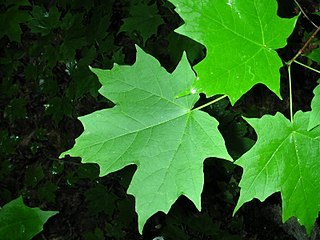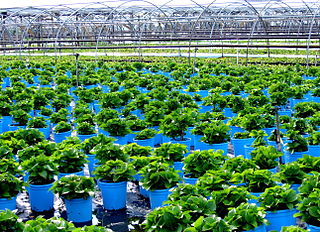Related Research Articles

An extremophile is an organism that is able to live in extreme environments, i.e. environment that make survival challenging such as due to extreme temperature, radiation, salinity, or pH level.

Acer saccharum, the sugar maple, is a species of flowering plant in the soapberry and lychee family Sapindaceae. It is native to the hardwood forests of eastern Canada, from Nova Scotia west through southern Quebec, central and southern Ontario to southeastern Manitoba around Lake of the Woods, and northcentral and northeastern United States, from Minnesota eastward to Maine and southward to northern Virginia, Tennessee and Missouri. Sugar maple is best known for being the primary source of maple syrup and for its brightly colored fall foliage. It may also be known as "rock maple", "sugar tree", "birds-eye maple", "sweet maple", "curly maple", or "hard maple", particularly when referring to the wood.
Autecology is an approach in ecology that seeks to explain the distribution and abundance of species by studying interactions of individual organisms with their environments. An autecological approach differs from both community ecology (synecology) and population ecology by greater recognition of the species-specific adaptations of individual animals, plants or other organisms, and of environmental over density-dependent influences on species distributions. Autecological theory relates the species-specific requirements and environmental tolerances of individuals to the geographic distribution of the species, with individuals tracking suitable conditions, having the capacity for migration at at least one stage in their life cycles. Autecology has a strong grounding in evolutionary theory, including the theory of punctuated equilibrium and the recognition concept of species.
A mesophile is an organism that grows best in moderate temperature, neither too hot nor too cold, with an optimum growth range from 20 to 45 °C. The term is mainly applied to microorganisms. Organisms that prefer extreme environments are known as extremophiles. Mesophiles have diverse classifications, belonging to two domains: Bacteria, Archaea, and to kingdom Fungi of domain Eucarya. Mesophiles belonging to the domain Bacteria can either be gram-positive or gram-negative. Oxygen requirements for mesophiles can be aerobic or anaerobic. There are three basic shapes of mesophiles: coccus, bacillus, and spiral.
Acclimatization or acclimatisation is the process in which an individual organism adjusts to a change in its environment, allowing it to maintain fitness across a range of environmental conditions. Acclimatization occurs in a short period of time, and within the organism's lifetime. This may be a discrete occurrence or may instead represent part of a periodic cycle, such as a mammal shedding heavy winter fur in favor of a lighter summer coat. Organisms can adjust their morphological, behavioral, physical, and/or biochemical traits in response to changes in their environment. While the capacity to acclimate to novel environments has been well documented in thousands of species, researchers still know very little about how and why organisms acclimate the way that they do.

A nursery is a place where plants are propagated and grown to a desired age. They include retail nurseries, which sell to the general public, wholesale nurseries, which sell only to businesses such as other nurseries and to commercial gardeners, and private nurseries, which supply the needs of institutions or private estates.
A hyperthermophile is an organism that thrives in extremely hot environments—from 60 °C upwards. An optimal temperature for the existence of hyperthermophiles is often above 80 °C. Hyperthermophiles are often within the domain Archaea, although some bacteria are also able to tolerate extreme temperatures. Some of these bacteria are able to live at temperatures greater than 100 °C, deep in the ocean where high pressures increase the boiling point of water. Many hyperthermophiles are also able to withstand other environmental extremes, such as high acidity or high radiation levels. Hyperthermophiles are a subset of extremophiles. Their existence may support the possibility of extraterrestrial life, showing that life can thrive in environmental extremes.
A limiting factor is a variable of a system that causes a noticeable change in output or another measure of a type of system. The limiting factor is in a pyramid shape of organisms going up from the producers to consumers and so on. A factor not limiting over a certain domain of starting conditions may yet be limiting over another domain of starting conditions, including that of the factor.
Cryptobiosis or anabiosis is a metabolic state of life entered by an organism in response to adverse environmental conditions such as desiccation, freezing, and oxygen deficiency. In the cryptobiotic state, all measurable metabolic processes stop, preventing reproduction, development, and repair. When environmental conditions return to being hospitable, the organism will return to its metabolic state of life as it was prior to the cryptobiosis.
A thermal optimum is either a portion of a specified geological time span in which the average temperature was above that of the average temperature for the entire specified time or the optimum range within which a biological process may take place or the ambient optimal range for a species' niche.
Climatic adaptation refers to adaptations of an organism that are triggered due to the patterns of variation of abiotic factors that determine a specific climate. Annual means, seasonal variation and daily patterns of abiotic factors are properties of a climate where organisms can be adapted to. Changes in behavior, physical structure, internal mechanisms and metabolism are forms of adaptation that is caused by climate properties. Organisms of the same species that occur in different climates can be compared to determine which adaptations are due to climate and which are influenced majorly by other factors. Climatic adaptations limits to adaptations that have been established, characterizing species that live within the specific climate. It is different from Climate change adaptations which refers to the ability to adapt to gradual changes of a climate. Once a climate has changed, the climate change adaptation that led to the survival of the specific organisms as a species can be seen as a climatic adaptation. Climatic adaptation is constrained by the genetic variability of the species in question.

Intertidal ecology is the study of intertidal ecosystems, where organisms live between the low and high tide lines. At low tide, the intertidal is exposed whereas at high tide, the intertidal is underwater. Intertidal ecologists therefore study the interactions between intertidal organisms and their environment, as well as between different species of intertidal organisms within a particular intertidal community. The most important environmental and species interactions may vary based on the type of intertidal community being studied, the broadest of classifications being based on substrates—rocky shore and soft bottom communities.
The storage effect is a coexistence mechanism proposed in the ecological theory of species coexistence, which tries to explain how such a wide variety of similar species are able to coexist within the same ecological community or guild. The storage effect was originally proposed in the 1980s to explain coexistence in diverse communities of coral reef fish, however it has since been generalized to cover a variety of ecological communities. The theory proposes one way for multiple species to coexist: in a changing environment, no species can be the best under all conditions. Instead, each species must have a unique response to varying environmental conditions, and a way of buffering against the effects of bad years. The storage effect gets its name because each population "stores" the gains in good years or microhabitats (patches) to help it survive population losses in bad years or patches. One strength of this theory is that, unlike most coexistence mechanisms, the storage effect can be measured and quantified, with units of per-capita growth rate.
Ecological forecasting uses knowledge of physics, ecology and physiology to predict how ecological populations, communities, or ecosystems will change in the future in response to environmental factors such as climate change. The ultimate goal of the approach is to provide people such as resource managers and designers of marine reserves with information that they can then use to respond, in advance, to future changes, a form of adaptation to global warming.
Desiccation tolerance refers to the ability of an organism to withstand or endure extreme dryness, or drought-like conditions. Plants and animals living in arid or periodically arid environments such as temporary streams or ponds may face the challenge of desiccation, therefore physiological or behavioral adaptations to withstand these periods are necessary to ensure survival. In particular, insects occupy a wide range of ecologically diverse niches and, so, exhibit a variety of strategies to avoid desiccation.

High-temperature operating life (HTOL) is a reliability test applied to integrated circuits (ICs) to determine their intrinsic reliability. This test stresses the IC at an elevated temperature, high voltage and dynamic operation for a predefined period of time. The IC is usually monitored under stress and tested at intermediate intervals. This reliability stress test is sometimes referred to as a "lifetime test", "device life test" or "extended burn in test" and is used to trigger potential failure modes and assess IC lifetime.
The geographical limits to the distribution of a species are determined by biotic or abiotic factors. Core populations are those occurring within the centre of the range, and marginal populations are found at the boundary of the range.
Neobodo are diverse protists belonging to the eukaryotic supergroup Excavata. They are Kinetoplastids in the subclass Bodonidae. They are small, free-living, heterotrophic flagellates with two flagella of unequal length used to create a propulsive current for feeding. As members of Kinetoplastids, they have an evident kinetoplast There was much confusion and debate within the class Kinetoplastid and subclass Bodonidae regarding the classification of the organism, but finally the new genera Neobodo was proposed by Keith Vickerman. Although they are one of the most common flagellates found in freshwater, they are also able to tolerate saltwater Their ability to alternate between both marine and freshwater environments in many parts of the world give them a “cosmopolitan” character. Due to their relatively microscopic size ranging between 4-12 microns, they are further distinguished as heterotrophic nanoflagellates. This small size ratio limits them as bacterivores that swim around feeding on bacteria attached to surfaces or in aggregates.

Anthropocentric climate change has been found to bring about the increase in temperature and precipitation in a range of ecosystems. The drastic change of these climate factors is predicted to progress leading to the destabilization of ecosystems. Human-caused climate change and the rise in invasive species are directly linked through changing of ecosystems. The destabilization of climate factors in these ecosystems can lead to the creation of a more hospitable habitat for invasive species- species that not historically found in the impacted regions. Thus, invasive species are able to spread beyond their original boundaries. This relationship is notable because climate change and invasive species are also considered by the USDA to be two of the top four causes of global biodiversity loss.
Ecocrop was a database used to determine the suitability of a crop for a specified environment. Developed by the Food and Agriculture Organization of the United Nations (FAO) it provided information predicting crop viability in different locations and climatic conditions. It also served as a catalog of plants and plant growth characteristics.